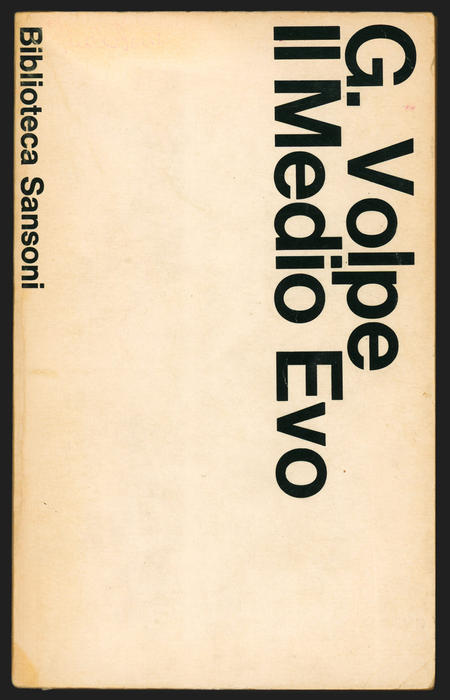Biblioteca Sansoni
Massimo Vignelli, 1964
Part of Sezione Tascabili
"The fundamentals of modern cultural consciousness: a classic collection of works on history, philosophy, aesthetics, literary criticism, economics, sociology, science and the history of science that will allow every reader to build up an ideal library at an economic price".
Not the only "biblioteca" (library) published by Sansoni, but the first to present the best in historical, critical, philosophical, scientific and literary criticism fields in a modern guise and at affordable prices. Federico Gentile, then under the control of the publishing house, first gave the control of the series to Orazio Pugliese for the first 40 volumes, and then to Gianna Buti for a further 40 titles. There weren't only authors already published by Sansoni, such as Kierkegaard and Rosenberg, Gentile or Spirito, Burckhardt or Cantimori, but also classics such as Paolo Sarpi's L'Istoria del Concilio Tridentino and new authors including Herman Gunkel, Denis Hay, Jerome Ch'ên and Augusto Simonini.
The covers of the Biblioteca Sansoni were an absolute novelty for the time: they were designed by Massimo Vignelli, who was already working on other covers of the same publishing house, such as the three volumes of the Leonardo encyclopedia or some texts for middle school. The origins of the collaboration between Vignelli and Sansoni (which later ended with the dissolution of Unimark Milano in the early 1970s) are not clear, especially considering the relative difference in political environments.
Yet there was a clear desire to modernize the entire production of the publishing house of the time starting with the abandonment of the historic monogram in favor of a logo set in Helvetica. One could speculate this was all due to the existing rivalry between Sansoni and Vallecchi, both Florentine, since the collaboration between Bob Noorda (also part of Unimark) and Vallecchi had already been going on for some years.
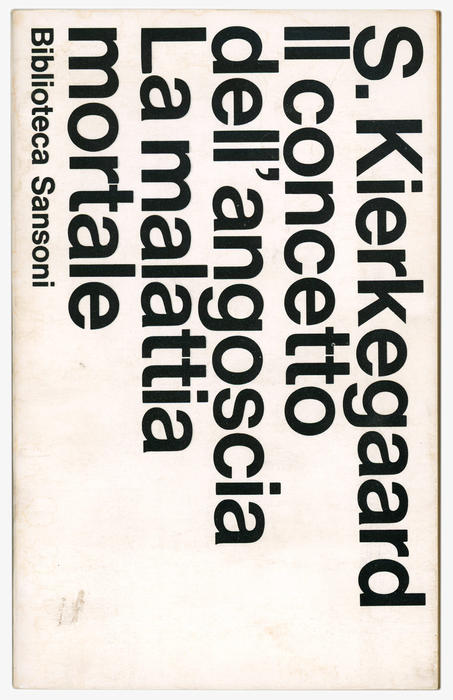
Søren Kierkegaard, "Il concetto dell’angoscia / La malattia mortale"
Biblioteca Sansoni 1, October 1973 (5a edizione)
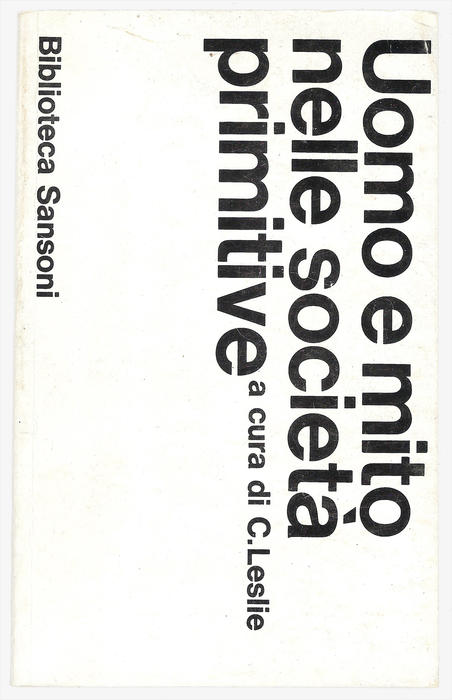
Charles Leslie, "Uomo e mito nelle società primitive"
Biblioteca Sansoni 2, May 1965 (1a edizione)
Gioacchino Volpe, "Il Medio Evo"
Biblioteca Sansoni 3, June 1967 (3rd edition)

Leopold von Ranke, "Storia dei Papi"
Biblioteca Sansoni 4, August 1965 (1a edizione)
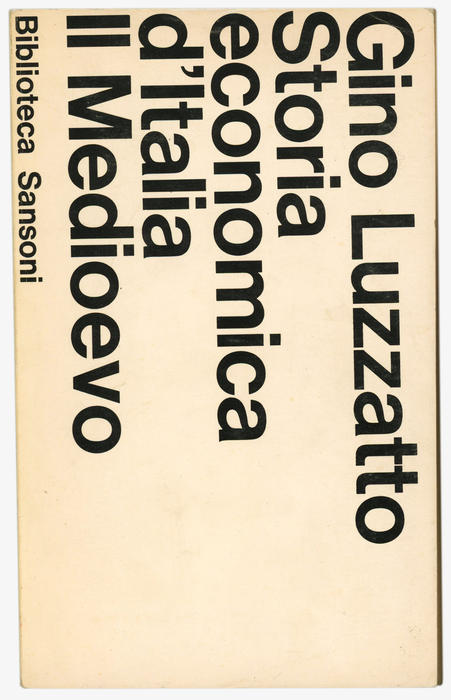
Gino Luzzatto, "Storia economica d’Italia. Il Medioevo"
Biblioteca Sansoni 29, May 1975 (2a edizione (4a ristampa))
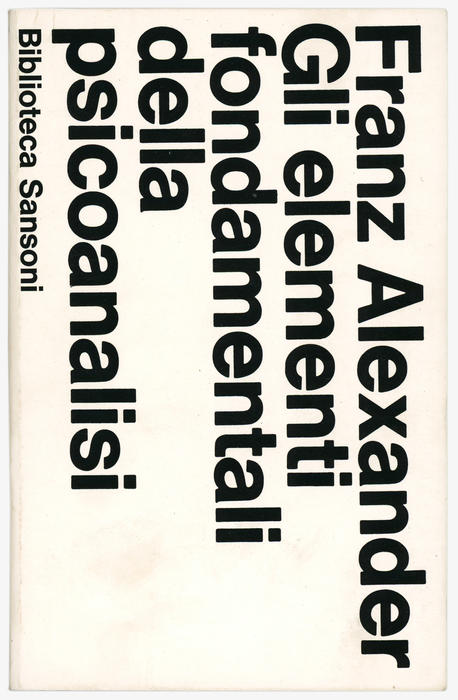
Franz Alexander, "Gli elementi fondamentali della psicoanalisi"
Biblioteca Sansoni 46, November 1969 (1a edizione)
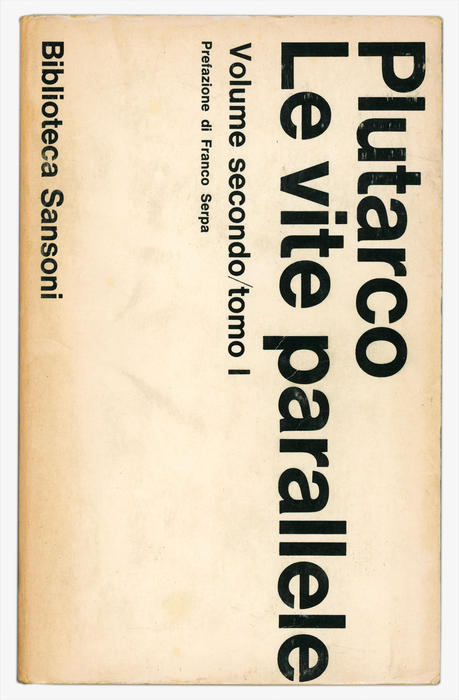
Plutarco, "Le vite parallele. Volume secondo / tomo 1"
Biblioteca Sansoni 84, January 1974 (1a edizione)
Sansoni
Florentine publishing house founded in 1873 by Giulio Cesare Sansoni initially specialized in literary works for the most part aimed at schools and universities, starting with Italian and Greek classics. In 1932 Sansoni was acquired by Giovanni Gentile, at the time president of the Normale di Pisa and a leading exponent of fascist culture, giving a more historical and philosophical imprint to the new publications. At the tragic conclusion of the Italian Social Republic, his son Federico took over the reins of the publishing house, starting the publication of encyclopedias and dictionaries. Sansoni was sold to Rizzoli in 1976, subsequently becoming a non-fiction and university textbook brand owned by Mondadori. To this day the brand is still used for high school texts.
Massimo Vignelli
He was born in Milan in 1931. He completed his architectural studies in Milan and Venice and therefore engaged in multiple disciplines of design together with his wife Lella, architect and sister of Gino Valle. Vignelli's most significant achievements are placed at the turn of the sixties and seventies when, co-founder of Unimark International, he designed the coordinated system of the New York subway signage with Bob Noorda and the Washington subway system with P. Van Delft.
In 1964 he designed the image of the Piccolo Teatro in Milan; in 1967 he designed the American Airlines logo (which remained unchanged for almost 50 years) and was responsible for setting up for Olivetti, Pirelli, Rank Xerox, fine-tuning the corporate identities of the companies Brionvega, Zanussi, Lancia, Ciga Hotels and others. In the editorial graphics sector, he designs or redesigns the headings of various newspapers, including The Herald of 1971 and The European Journal of '78, or more recently the Japanese architecture magazine A + U. Numerous illustrated volumes come out of the long collaboration with Rizzoli, including the series for architect Richard Meier still in print.
More recently, we remember the identity projects for Benetton, Sisley and the system of signs for the stations of the Italian railways. Among the numerous prizes and awards: two Compassi d'Oro (1964 and 1998), Triennale Grand Prix of Milan and gold medal of the American Institute of Graphic Art in 1983. He died in New York 2014, leaving behind a vast collection of artefacts and extraordinarily more creative projects than the 1960s production, many still unpublished.
